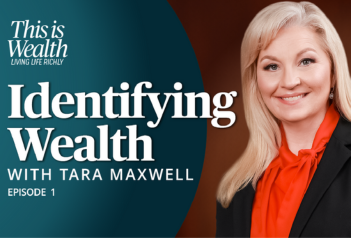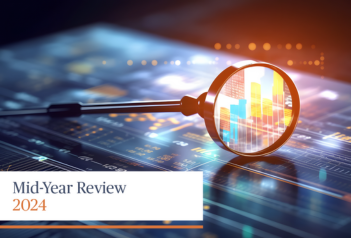Christmas and the holiday season are full of family traditions. It is a time to reflect on the year that has passed and to set new goals. Asset managers and investors also have a ritual to highlight what worked well in their portfolios as well as what did not pan out. Predictions and outlooks for the next year also garner attention. The legendary investor Byron Wien is well known for publishing his highly anticipated “Ten Surprises” every year.
A couple of years ago we started putting our own bullish and bearish scenarios for the market in a slide simply named our “Bull-Bear-Base.” We look forward to sharing our 2022 scenarios in the next few weeks.
I envision our Bull case to account for a continued economic recovery on the back of strong consumer demand and income. Fed Chair Jerome Powell just gave us an upbeat view of the economy at last week’s Federal Open Market Committee meeting. Corporate profits growing at 7.5% in 2022 and the Fed tackling inflation pressures by raising rates are positives. The Bear case most likely includes a monetary policy mistake, a potential slowdown or even downturn in the economy, as well as a market correction given current valuations.
The process to get to these scenarios is a collaborative discussion about multiple expansion and earnings growth, interest rate and inflation expectations, economic cycles, and a heavy dose of skepticism. Sprinkle in a few “what-ifs” and the foundation to our overall asset allocation takes place.
As investors and risk managers, the starting and ending points are less relevant than the journey. Markets go up and markets go down. Our goal is to have client portfolios fully participate in the positive years and offer protection in the down times. Whatever the “average” return for the market ends up being in any one year — which according to FactSet is 10.3% for the S&P 500 since 1926 — we prefer to prepare portfolios for non-consensus scenarios that fall outside of a normal distribution of events. For example, what would happen if the dollar collapsed or if a liquidity crisis emerges from an emerging market country? We believe in being prepared, not lucky.
A Sendero tradition that our founder Fred Middleton started early in his career is our, “Reasons why people did not invest in the stock market.” This annual list goes back to 1934 and highlights an event or a reason why you should not invest in the S&P 500. Negative stock market returns occur, on average, about one out of every four years. Historical data shows that the positive years far outweigh the negative years. If you choose to invest in stocks, learn to expect the down years. The punchline is that over the long-term, the best decision is to stay invested and participate as investing works over long time periods.
At the end of the year, I will add “2021— Supply Chains/Inflation Fears” and add 27% — as of Dec. 15 — to the list of worries.
| 1934 | Depression | 1977 | Inflation Increases |
| 1935 | Spanish Civil War | 1978 | Interest Rates Rise |
| 1936 | Economy Still Struggling | 1979 | Oil Prices Skyrocket |
| 1937 | Recession | 1980 | Interest Rates at All Time Highs |
| 1938 | War Clouds Gather | 1981 | Steep Recession Begins |
| 1939 | War in Europe | 1982 | Worst Recession Begins |
| 1940 | France Falls | 1983 | Markets Hit New Highs |
| 1941 | Pearl Harbor | 1984 | Record Federal Deficits |
| 1942 | Wartime Price Controls | 1985 | Economic Growth Slows |
| 1943 | Industry Mobilizes | 1986 | Dow Nears 2000-Market Too High |
| 1944 | Consumer Goods Shortage | 1987 | Market Declines 20% in One Day |
| 1945 | Post-War Recession Predicted | 1988 | Savings and Loan Crisis |
| 1946 | Dow Tops 20 – Market Too High | 1989 | Bank Failures Increase |
| 1947 | Cold War Begins | 1990 | Persian Gulf Crisis |
| 1948 | Berlin Blockade | 1991 | Dow Nears 3000-Market Too High |
| 1949 | Russia Explodes A-Bomb | 1992 | Global Recession |
| 1950 | Korean War | 1993 | Healthcare Reform |
| 1951 | Excess Profits Tax | 1994 | Collapse of Orange County |
| 1952 | U.S. Seizes Steel Mills | 1995 | Market Crosses 5000 |
| 1953 | Russia Explodes H-Bomb | 1996 | Lowest Dividend Yield Ever |
| 1954 | Dow Tops 360-Market Too High | 1997 | Asian Financial Crisis |
| 1955 | Eisenhower Illness | 1998 | Russian Default |
| 1956 | Suez Crisis | 1999 | Y2K |
| 1957 | Russia Launches Sputnik | 2000 | Tech Wreck |
| 1958 | Recession | 2001 | 9/11 Terrorist Attacks |
| 1959 | Castro Seizes Power in Cuba | 2002 | Dow Closed Lowest Level in 5 Years |
| 1960 | Russian Downs U-2 Plane | 2003 | Iraqi War |
| 1961 | Berlin Wall Erected | 2004 | Asian Tsunami |
| 1962 | Cuban Missile Crisis | 2005 | Recession |
| 1963 | Kennedy Assassinated | 2006 | Slumping Housing Market |
| 1964 | Gulf of Tonkin | 2007 | Subprime Mortgage Crisis Begins |
| 1965 | Civil Rights Marches | 2008 | Massive Stock Market Declines |
| 1966 | Vietnam War Escalates | 2009 | S&P Drops 18.2% in First Two Months |
| 1967 | Newark Race Riots | 2010 | Sovereign Debt Crisis |
| 1968 | USS Pueblo Seized | 2011 | Triple A Rating on US Treasuries Lost |
| 1969 | Money Tightens-Markets Fall | 2013 | Taper Tantrum |
| 1970 | Cambodia Invaded- Vietnam | 2014 | Oil Prices Begin Large Decline |
| 1971 | Wage Price Freeze | 2015 | China Growth Fears Plague Markets |
| 1972 | Largest U.S. Trade Deficit Ever | 2016 | Crude hit a low of $27.10 |
| 1973 | Energy Crisis | 2017 | Terrorism and N. Korea tension |
| 1974 | Watergate | 2018 | Taper Tantrum |
| 1975 | Resources Shortage | 2019 | Trade War with China |
| 1976 | Limit to Long Term Growth | 2020 | Global Pandemic |
And ONE Good Reason Why You Should:
$10,000 Invested in the Stock Market (S&P 500 Index) in January of 1934 would be worth nearly $78,458,331.26 as of December 31, 2020.
On behalf of all of us at Sendero, we wish you happy holidays!
If you have any questions or want to have a conversation about the market or your portfolio, please contact Liz, Ed, Fred, Scott, Tyler, or myself. Your Sendero team is ready to help.
Best Regards,
Amaury de Barros Conti
210-930-9409
aconti@sendero.com


